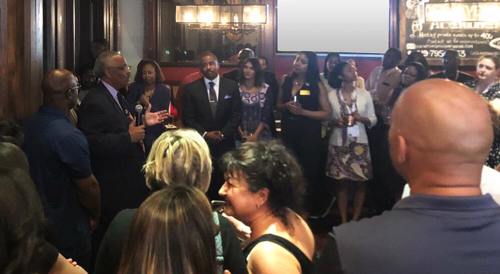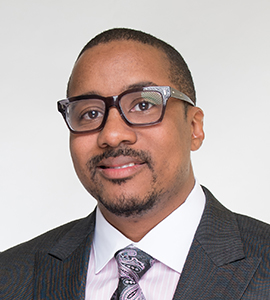According to census population projections, the United States could become "minority white" as early as 2045. However, when it comes to attracting diverse healthcare providers and leaders, the medical profession lags behind.
- As of 2016, only 13% of medical students are black or Latino.
- Although this same group represents 30% of the U.S. population, they represent less than 10% of practicing physicians.
- Women now represent half of all medical school graduates. However, only 19% of hospitals and 4% of healthcare organizations are led by women.
- Fifty-six percent of people who identify as LGBTQ have experienced healthcare discrimination. However, few medical schools and organizations are reaching out to recruit more sexual-minority providers. Meanwhile, LGBTQ medical students widely perceive discrimination within the medical education system.

Dr. Brummer championed the creation of the yearly Executive Leadership Diversity Summit at ACEP's annual scientific assembly. He's also the principal founder of the Dr. Wes Curry Emergency Medicine Leadership Honor that recognizes innovation, collaboration, and culture building by diverse healthcare leaders.
In today's post, Dr. Brummer shares his thoughts on how healthcare organizations can promote and celebrate diversity in medicine.
Why is it crucial for healthcare organizations to attract a diverse workforce?
Dr: Brummer: While the overall health of our population has improved, health disparities persist. People of color are more likely to be uninsured or underinsured, to delay needed care, to suffer from certain conditions, to die from these conditions, and to die sooner overall. It's important to address healthcare disparities not only for social justice reasons but also to control costs and improve quality across our entire healthcare system.
One of the best ways to fight disparities is to hire providers that reflect the diversity of the community they serve. Diverse physicians can provide culturally competent care and overcome language and communication barriers.
Research also suggests that diverse patients are more likely to comply with treatments prescribed by a doctor who looks like them. For example, black men who see black doctors are significantly more likely to get routine screenings and flu shots.
On a personal level, why are you passionate about promoting diversity in medicine?
Dr. Brummer: At the start of my medical career, I really didn't have a mentor. I wanted to try my hand at administration, but I didn't have the platform or the experience.
Things started to change when I joined Vituity. At that time, our CEO, Wes Curry, was the only black physician I had ever seen leading a large medical group. Dr. Curry really took an interest in my career and helped me understand how to navigate effectively as a minority leader. He equipped me with the tools and opportunities to have a successful long-term executive career.
Dr. Curry's mentorship made such a difference in my life that I'm inspired and grateful to pay it forward. I really want to open up the executive experience and opportunities to the next generation of physicians — particularly those from underrepresented minorities, as they are so underrepresented in medicine.
The Vituity Executive Leadership Diversity Summit was an effort to create a structure and scale for diversity programs — both within Vituity and the wider emergency medicine community.
What inspired you to start the Diversity Summit? And what's next for the summit?
Dr. Brummer: Seven years ago, I had a vision to bring together diverse executives from different organizations to talk freely about the business of emergency medicine. The annual ACEP Scientific Assembly was a natural place to gather, and Vituity now sponsors the summit every year.
Today, the Executive Leadership Diversity Summit has turned into a premier networking event with executives from hospitals, health systems, medical groups, and insurance companies all attending and joining the conversation.
Going forward, we look to continue our relationship with ACEP and supporting its new diversity section in hopes of raising awareness about diversity in medicine and opening up new opportunities for diverse providers.
And finally, we'll also use the Diversity Summit to announce and celebrate the honorees of the Wes Curry Executive Leadership Award. Winners are chosen based on their achievements in leadership, innovation, collaboration, and culture building.

What about Dr. Curry's life and work inspired you to create this award?
Dr. Brummer: Dr. Curry is a titan in emergency medicine. He spent 25 years leading Vituity and building it into a billion-dollar company back at a time when very few black Americans were leading large medical groups.
Now today, we are seeing more minority executives heading huge organizations, such as Bernard Tyson at Kaiser Permanente or Patricia Maryland at Ascension. However, I really believe Dr. Curry was perhaps the earliest pioneer who paved the way for future minority executives — and also mentored and elevated many diverse leaders along the journey.
In your experience, how does Vituity support diverse physicians and leaders?
Dr. Brummer: Vituity has many initiatives to promote diversity and support diverse providers and leaders within our organization. In addition to our Diversity Summit, some standout examples include our Vituity Women in Medicine workgroup, a Diversity and Inclusion committee that organizes educational and cultural events, and a visa program that provides a path to partnership for foreign medical graduates.
But I think in our case, the proof really is in the pudding. When you look at our executive suite, our board of directors, and our corps of medical directors, you'll see women, people of color, and people who identify as LGBTQ well represented.
You can also look at where we work. Vituity currently manages emergency departments serving diverse communities in Chicago, Atlanta, and Los Angeles. We even manage the ED at Howard University Hospital, the largest historically black teaching hospital located on the campus of a historically black university (and my proud alma mater).
Are we perfect? Not by a long shot. There are definitely some areas where we could improve. But overall, Vituity has hands down the most diverse leadership I've seen in a healthcare organization. And personally, it makes me proud to work here.
What are some first steps organizations can take to build a more diverse workforce and leadership corps?
Dr. Brummer: First, it's important to build diversity across all levels of leadership, from medical directors to the C-suite. Diverse leaders tend to attract more diverse talent to the organization and nurture those hires into leadership positions.
Second, create a standardized mentoring platform where people at the senior level mentor physicians from underrepresented minorities and show them how to thrive within our system. As the head of our Women in Medicine committee likes to say, "You can't be it if you can't see it!" So make sure that your diverse hires have a chance to learn from someone who looks like them and understands the challenges they face.
Finally, invest in cultural competency training. Not only will it show your commitment to your diverse providers, it will also help your organization to address health disparities and provide better care for all.
Thanks so much for talking with us today, Dr. Brummer. Any final words before we sign off?
Dr. Brummer: My pleasure. And as you can tell, diversity in medicine is something I'm incredibly passionate about. Finding the right organization and the right mentor at the right time changed the course of my career.
So it's important to pause sometimes in our busy lives and practices to give that same hand up to others.

























